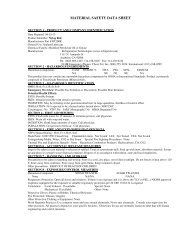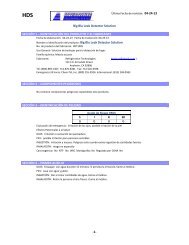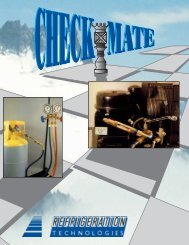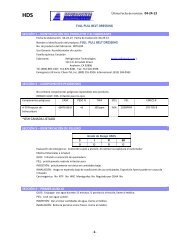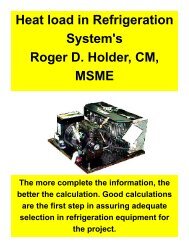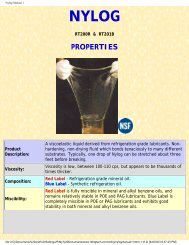Balancing of a Water and Air System (PDF
Balancing of a Water and Air System (PDF
Balancing of a Water and Air System (PDF
Create successful ePaper yourself
Turn your PDF publications into a flip-book with our unique Google optimized e-Paper software.
51<br />
duct may be great; the balancing device must be able to make a fine airflow adjustment<br />
against this pressure difference. It is best to provide two balancing devices in series,<br />
such as an orifice plate or blast gate for coarse adjustment followed by an opposedblade<br />
damper for fine adjustment.<br />
Directly measuring air velocities in the exhaust ductwork to assess exhaust system<br />
performance may be desirable. Velocity (pitot-tube) traverses may be performed in<br />
kitchen exhaust systems, but holes drilled for the pitot tube must be liquid tight to<br />
maintain the fire-safe integrity <strong>of</strong> the ductwork per NFPA St<strong>and</strong>ard 96. Holes should<br />
never be drilled in the bottom <strong>of</strong> a duct, where they may collect grease. Velocity traverses<br />
should not be performed when cooking is in progress because grease collects on the<br />
instrumentation.<br />
PRINCIPLES AND PROCEDURES FOR BALANCING HYDRONIC SYSTEMS<br />
Both air- <strong>and</strong> water-side balance techniques must be performed with sufficient accuracy<br />
to ensure that the system operates economically, with minimum energy, <strong>and</strong> with proper<br />
distribution. <strong>Air</strong>side balance requires precise flow measuring because air, which is<br />
usually the prime heating or cooling transport medium, is more difficult to measure in the<br />
field. Reducing airflow below design airflow reduces heat transfer directly <strong>and</strong> linearly<br />
with respect to waterside flow. In contrast, the heat transfer rate for the waterside does<br />
not vary linearly with the water flow rate through a heat exchanger (coil), because <strong>of</strong> the<br />
characteristics <strong>of</strong> heat exchangers. As a result, waterside heat transfer is less sensitive<br />
to changes in flow, <strong>and</strong> the required accuracy <strong>of</strong> flow is lower when using traditional<br />
design criteria. The relatively high pressures associated with hydronic systems allow for<br />
easier measurement <strong>of</strong> pressure, although application <strong>of</strong> flow <strong>and</strong> head relationships<br />
should be thoroughly understood.<br />
51




